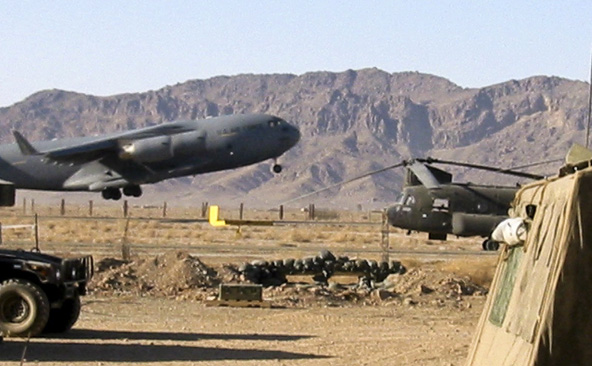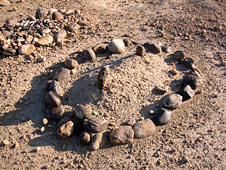
February, 2002. A military aircraft taking off at Kandahar airport, where the U.S. military set up operations. Special forces calling themselves, Damage Inc. participated in an attack on a town in Oruzgun killing an number of men while they slept. News agencies were afraid to run the story.
Photo: Phillip Robertson
Feb. 21, 2002 | KANDAHAR, Afghanistan
There were high-ranking commanders and regular fighters, some still very young, and because there wasn't much happening, they all waited quietly. They must have been there for hours. At around 10 a.m., when a cargo plane started its final approach to the airport, the fighters turned and watched it come in low over the desert, shielding their eyes from the sun.
But the leviathan plane brought a weird sound with it, a deep, forbidding hum that shook the bones of the onlookers, and for some mysterious reason matched the opening note of Radiohead's "I Might Be Wrong." It was the secret anthem for a war that had started above ground in September but had in a matter of months burrowed back into the hills and out of our sight, documented by increasingly fragmentary and ridiculous Pentagon reports. We got statements like, "We take great care to endure that we are engaging confirmed Taliban or al-Qaida facilities." You can hear the hiss as such sentences come out of the freshly opened can. The fighters outside the gates of the base were waiting for the body of Commander Qasim Jan, who was killed by a mis-targeted 2,000 pound bomb on Dec. 5 just north of Kandahar. The same explosion also killed three U.S. Special Forces personnel and five more anti- Taliban fighters; the disaster was due either to human error or a technical glitch in the bomb's guidance system. At least 38 others were wounded in the attack. As the press walked around in the bright sun trying to find a story, any story, a ritual was beginning just inside the gates to the base. A red pickup driven by an Afghan commander had been allowed in, and a plywood casket was placed in the bed, covered in a black, green and red flag, the old national symbol of Afghanistan.
Members of the Special Forces stood near the truck for a minute and then it headed back out the gates, where two young fighters jumped into the back, touching the box very gently, making sure that the flag on it stayed straight and presentable. As the truck pulled up with Qasim Jan's body, there was complete and utter silence. The Afghans stood perfectly still, and the reporters bowed their heads. Then, the hearse truck made a slow left turn and went down the line of fighters who rushed to get in their vehicles and follow the body back to Kandahar. It took less than 45 seconds for all of them to disappear.
The December 5th bombing that killed Qasim Jan was one of the U.S. military's high- profile mistakes in its four-month involvement in Afghanistan. In recent weeks, word has spread of anotherthe massacre at Oruzganwhere a unit of pro-Karzai fighters was apparently mistaken for the Taliban. At least 21 Afghan soldiers were killed in the attack. Though the U.S. forces here have been tight-lipped about exactly what happened at Oruzgan, it appears that the raid was launched after U.S. forces received bad intelligence information. They thought they were fighting a pro-Taliban death squad. In Afghanistan, bad information can be the difference between a death squad and an effective anti- terrorist force. It took 45 minutes to clear security at the base. When the Humvee turned and headed toward the terminal, Globe and Mail reporter Mark MacKinnon and I followed in his Corolla. The Humvee led us past a field where a machine was kicking up a tornado of dust by whipping the ground with chains. It was a flail, searching for mines. We parked at a roundabout, got out and walked to the search area, where we took off our boots, were sniffed by dogs, and were watched over by men with some serious death machinery at their disposal. The situation clearly required a certain amount of intense paranoia by security. We all knew why, after spending more than one night in Kandahar, and didn't have a problem with the searches. Inside the terminal, I looked out at the low mountains that separated the airport from Kandahar proper
Once we were on the base, which was a strange organism that started out life as a civilian airport and was quickly growing into a heavily armed small town, I learned that the military offered the press an interesting deal. You could spend the night on the base if you brought your stuff, but there were no in-and-out privileges. If you left the base, you had to wait until the next morning to get back in, no arguments, no bending the rules; it was the military and its aggregate brain, functioning with strange, oiled clicks that didn't allow for ambiguity. Security reasons, sir. A truly mammoth category with an infinite number of cubbyholes, which allowed for a fair bit of censorship and accounted for several very good photographers' being kicked off for taking perfectly legitimate pictures of the prisoners.
The very first piece of advice imparted by Maj. Ignacio Perez was that we weren't allowed to move around the base without an escort. Then he walked us inside and forgot about us.
The terminal building had a fountain in its center, open to the air like the hole of a donut, surrounded by the rest of the structure. One of the windows had been kicked out for easy access, and everyone, both press and soldiers, would hang out there, sitting on wooden boxes labeled "Do not burn, this is a chair," eating MRE's and killing time. Reporters would duck through the empty space to get a breath of fresh air, and since nothing was happening, the fountain was the social center of the zone. We waited around for the press briefing, scheduled for some incomprehensible hour thanks to Zulu time that had the military watches turned four and a half hours behind what seemed like normal. I'd only been there an hour, but I felt like the soldiers were mostly nervous around reporters and didn't know quite what to say.
 LEAD IMAGE: January, 2002. Nangarhar provice, Afghanistan. A child's grave in rocky soil.
LEAD IMAGE: January, 2002. Nangarhar provice, Afghanistan. A child's grave in rocky soil.Photo: Phillip Robertson
To contribute or commission a new Afghanistan assignment, click here.
© Phillip Robertson, 2009-2014.
